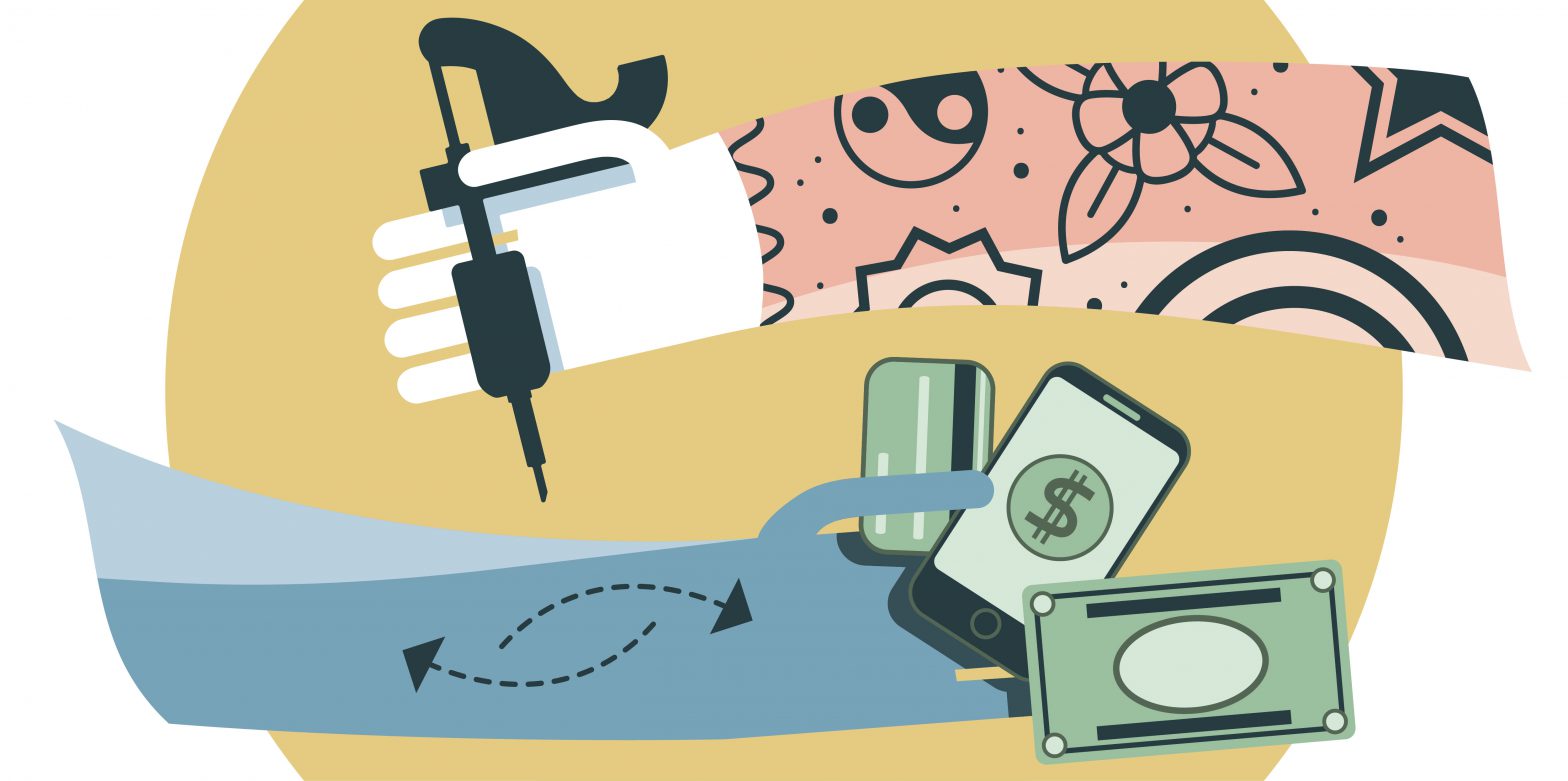Getting tattooed can be an expensive undertaking, typically costing upwards of $100 for even small designs. Given the cost of a new piece of ink, it’s easy to assume that all tattoo artists are raking it in, but the reality is that no tattooer takes home the full amount paid by their clients.
And while seasoned tattooers charge more than a novice or apprentice—meaning they bring in more money per appointment—they, like all artists, have a large number of expenses associated with their practice. The amount of each client payment that an artist has left over after additional expenses varies. Leah Samuels, resident artist at Baby, a private tattoo studio in Los Angeles, says that artists ultimately take home “anywhere from 70 percent to 50 percent, depending on the studio,” but for some, this percentage is lower. According to Yi Stropky, the Vancouver-based artist known for his clever, minimal style, says that “between 30 percent and 50 percent is normal.”
Exactly how artists are compensated differs, but daily cash payments are very common
Both Samuels and Stropky get paid by their studios at the end of each day, in cash. This is typical of most studios, says Jessica Coffey, owner of Bespoke Poke in St. John’s, Newfoundland, who was paid the same way before opening her own shop. When she launched Bespoke Poke, however, she officially incorporated the business “so that I could do things as by the books as I could.” Now all the money she makes by tattooing goes into a business account, and she gives herself paychecks once a month so it’s easier to keep track of her income and file her taxes at end of the year.
Artists don’t take home all the money paid by clients because the price of a tattoo helps cover necessary costs
The price of a tattoo helps cover a variety of costs associated with the process, explains Coffey, including supplies “such as needles, ink, gels, soaps and stencil cream, surface barriers, bandages and wraps” in addition to time and experience. Often, when clients are getting inked they assume their single expense is an artist’s time—time spent drawing and tattooing—but these hard costs add up month over month and as such are always relevant to the price of a design.
Samuels also says that the cost of a tattoo also helps pay for “rent and utilities for the space” or studio where an artist works. If your artist is working out of a studio or parlor, they must pay studio fees to those shops for allowing them to use their space and resources. Typically this is paid as a percentage of the cost of each tattoo, which, according to Samuels, ranges from “30 percent to 50 percent, depending on the shop.” Some shops also charge artists set rates rather than percentages, which differ from place to place based on the specific cost of maintaining their individual business.
Keep in mind most artists are self-employed, and thereby responsible for their own admin work, bookings, supplies, and finances
Most tattoo artists—including Samuels, Stropky and Coffey—consider themselves self-employed regardless of whether or not they have a dedicated shop to work out of, because that’s simply how the industry is structured. Some studios help tattooers coordinate bookings—more work for the artists leads to more revenue for the shop so it’s a win-win scenario—but often individual artists are responsible for all the work that comes along with being self-employed including managing their administrative duties such as schedules, finances, travel, and insurance. Stropky, for example, says “the actual tattooing time is just part of my job. I [also] need to respond to emails on a daily basis, do drawings, post on social media—I’m my own social media manager, and manage my finances. I’m also my own accountant, so there’s a lot of extra work to do.”
Because tattooers are paid only a percentage of the cost of each piece, tipping is encouraged, but not all artists expect it and tip amounts vary from place to place
Just as the amount you’d tip a server at a restaurant varies from place to place, so does tipping after being tattooed. Gratuities aren’t commonplace in certain European countries, for example, according to Stropky, so if you’re tattooing in those regions it’s unlikely you’ll receive any tips from clients. This is part of the reason Stropky, Samuels and Coffey share the same outlook regarding tips—they don’t expect them, but will always welcome them. “I personally don’t expect [tips], but they’re always nice,” says Coffey. “I’ve had some clients not tip and I’ve had some tip 15 percent which, in the moment, seems excessive because it’s actually pretty generous compared to what you normally get. I find the majority of individuals usually tack on five, 10, or 20 dollars to the price [of a piece].”
While it might not be common practice among clients to tip their tattoo artists, it is, however, common between tattooers themselves, according to Samuels, who says she usually tips her staff or resident artists around 20 percent.
Interested in becoming an artist, but wanna get the ball rolling sooner than the years training in an apprenticeship would allow? Consider joining the Inkbox Artist Community, which is always looking for talented artists in any medium to start selling their designs as Inkbox Tattoos. Just a heads up, Inside Out is powered by the folks at Inkbox. It’s all part of our shared mission to empower you to tell your unique story, be it for now or forever.

